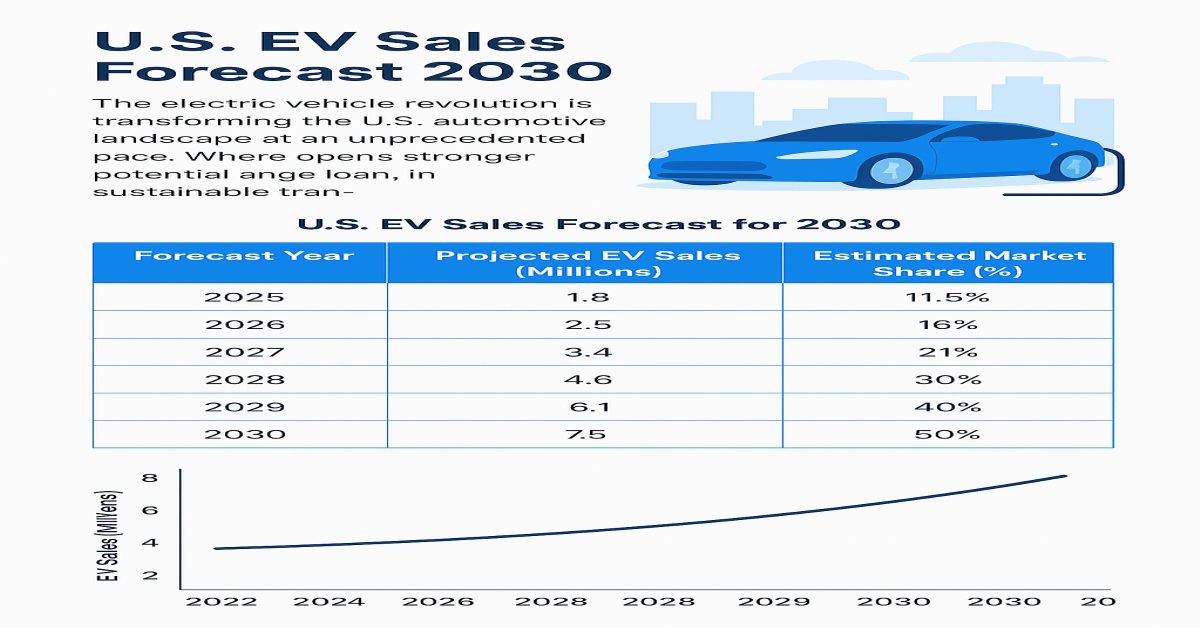Introduction
U.S. EV Sales Forecast 2030 revolution is transforming the U.S. automotive landscape at an unprecedented pace. With growing consumer awareness, government incentives, and major automakers shifting toward electrification, the U.S. EV sales forecast for 2030 shows remarkable potential. Analysts predict that by 2030, over 50% of new car sales in the U.S. could be electric, positioning the country as a global leader in sustainable transportation.
Current Market Overview (2024–2025)
The U.S. EV market is already showing robust growth. In 2024, EVs accounted for approximately 9% of total vehicle sales, representing over 1.3 million units sold. Brands such as Tesla, Ford, Chevrolet, Hyundai, and Rivian dominate the market, while newcomers continue to innovate with affordable EV options.
| Year | EV Units Sold (Approx.) | Market Share (%) | Top Selling Brands |
|---|---|---|---|
| 2022 | 918,000 | 6.2% | Tesla, Ford, Hyundai |
| 2023 | 1.1 million | 7.4% | Tesla, GM, Hyundai |
| 2024 | 1.3 million | 9.0% | Tesla, Ford, Rivian |
| 2025* (Projected) | 1.8 million | 11.5% | Tesla, Chevrolet, Hyundai |
U.S. EV Sales Forecast for 2030
By 2030, industry experts project that EV sales in the U.S. will surpass 7.5 million units annually, capturing between 45%–55% of the total vehicle market. This exponential growth is driven by rapid battery cost reductions, nationwide charging infrastructure expansion, and ambitious federal and state policies supporting clean energy vehicles.
| Forecast Year | Projected EV Sales (Millions) | Estimated Market Share (%) | Average EV Price (USD) |
|---|---|---|---|
| 2025 | 1.8 | 11.5% | $47,000 |
| 2026 | 2.5 | 16% | $44,000 |
| 2027 | 3.4 | 21% | $41,500 |
| 2028 | 4.6 | 30% | $39,000 |
| 2029 | 6.1 | 40% | $36,000 |
| 2030 | 7.5+ | 50%+ | $34,000 |
Key Drivers Behind EV Growth in the U.S.
1. Federal and State Incentives
The U.S. Inflation Reduction Act (IRA) continues to play a pivotal role in accelerating EV adoption. The federal EV tax credit of up to $7,500 per vehicle and various state-level rebates have made EVs more affordable for American households.
2. Expanding Charging Infrastructure
By 2030, the U.S. aims to install over 500,000 public EV charging stations across highways and urban areas. This infrastructure expansion reduces range anxiety and increases the convenience of owning electric cars.
3. Automaker Commitments
Major automotive manufacturers, including General Motors, Ford, and Stellantis, have pledged to phase out gasoline vehicles and focus on all-electric lineups by the early 2030s. Tesla, already a market leader, continues to innovate with advanced battery technology and software integration.
4. Environmental and Economic Benefits
Consumers are increasingly aware of environmental concerns. EVs produce zero tailpipe emissions, reducing urban pollution and dependence on fossil fuels. Additionally, EV maintenance costs are up to 40% lower than gasoline vehicles.
Challenges Ahead
Despite the optimistic outlook, several challenges could impact the U.S. EV market:
-
Battery Supply Chain: The need for lithium, cobalt, and nickel could lead to temporary production bottlenecks.
-
Charging Gaps in Rural Areas: Infrastructure development remains concentrated in urban centers.
-
Consumer Education: Many buyers still lack knowledge about long-term EV savings and technology.
However, these barriers are expected to diminish as technology advances and costs continue to fall.
Top Electric Vehicle Models Expected to Dominate by 2030
| Brand | Model Name | Range (Miles) | Expected Price (USD) | Battery Type |
|---|---|---|---|---|
| Tesla | Model Y / Model 2 | 300–350 | $30,000–$45,000 | Lithium-Ion / LFP |
| Ford | Mustang Mach-E / F-150 Lightning | 270–320 | $35,000–$55,000 | Nickel-Manganese |
| Chevrolet | Equinox EV / Silverado EV | 250–400 | $32,000–$50,000 | Ultium Platform |
| Hyundai | Ioniq 5 / Ioniq 7 | 280–350 | $35,000–$52,000 | Solid-State Ready |
| Rivian | R2 SUV / R1T | 300–400 | $45,000–$70,000 | Advanced Lithium-Ion |
Economic Impact on the U.S. Auto Industry
The EV revolution is reshaping the American job market and supply chain ecosystem. The growth in EV manufacturing, battery production, and charging infrastructure could create over 500,000 new clean-energy jobs by 2030. States like Michigan, Texas, and California are becoming EV manufacturing hubs.
Furthermore, the shift to EVs may reduce U.S. oil imports by millions of barrels annually, strengthening energy independence and reducing carbon emissions significantly.
Consumer Perspective: Why Americans Are Switching to EVs
The 2030 forecast is not only about numbers — it reflects changing consumer values. Modern buyers are attracted to:
-
Lower lifetime ownership costs
-
High-performance acceleration and design
-
Smart connectivity and autonomous driving features
-
Eco-conscious lifestyle choices
Surveys show that 3 out of 5 U.S. drivers are considering an EV as their next purchase, signaling strong market demand.
The Role of Technology and Innovation
Advancements in battery chemistry, AI-based energy management, and smart grid integration will play key roles in shaping the EV landscape. By 2030, solid-state batteries are expected to deliver faster charging times and longer ranges, making EVs even more practical for all demographics.
Expert Opinion
According to market analysts at Bloomberg NEF and the International Energy Agency (IEA), the U.S. will lead global EV adoption after China by 2030, with over 30 million EVs on the road. Their data suggests that the country’s policy momentum and private investment in EV infrastructure will drive a sustainable automotive future.
Conclusion: The Road to 2030 and Beyond
The U.S. EV sales forecast for 2030 paints a clear picture — electric vehicles are not the future; they are the present. The nation is on track to achieve mass EV adoption within the decade, fueled by innovation, affordability, and environmental awareness.
Consumers, automakers, and policymakers all play vital roles in this transformation. By 2030, electric vehicles will no longer be a niche product but a mainstream choice for millions of Americans.

1 thought on “U.S. EV Sales Forecast 2030: The Future of Electric Mobility”